Li S.Z., Jain A.K. (eds.) Encyclopedia of Biometrics
Подождите немного. Документ загружается.

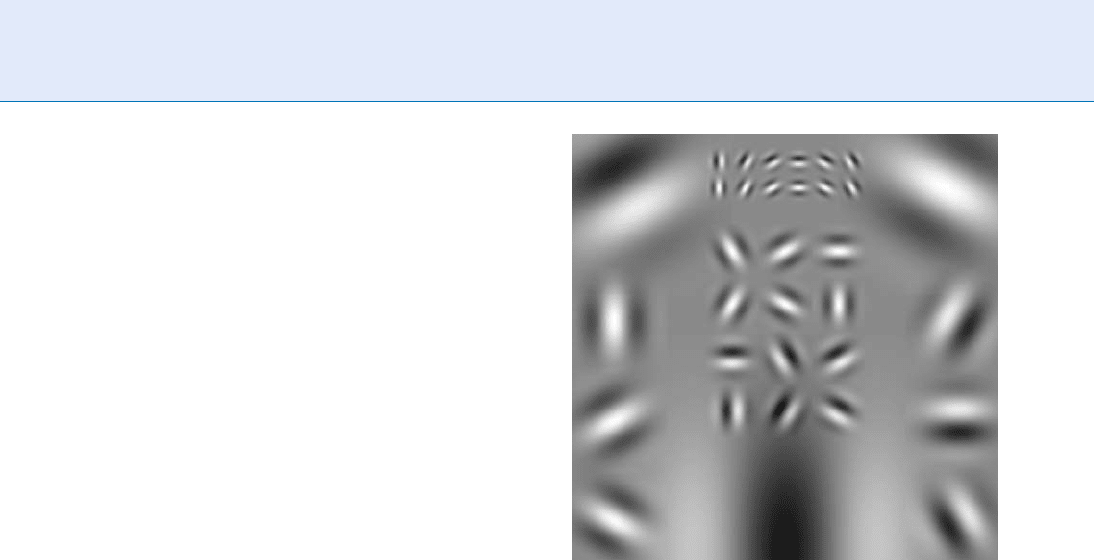
conditions have varied over the years. But perhaps the
main legacy of this development of what is also called
multiresolution analysis was the unification of the local
and the spectral perspectives into a single framework:
as the name ‘‘wavelet’’ implies, the terms of analysis
became simultaneously local, yet frequency-specific.
One important practical manifestation of these theo-
retical developments is found in JPEG-2000 compres-
sive image encoding, which is based on a class of
wavelets developed by Ingrid Daubechies [4].
But as early as 1946 a class of wavelet-like elem en-
tar y functions named logons (from the Greek word for
‘‘order’’) had been proposed by the Hungarian physi-
cist Denis Gabor [5], who also invented holography
and won the Nobel Prize in 1971. Although these
functions lack some of the stricter requirements on
wavelets, they satisfy more lax definitions and they
have certain advantages including being expressible in
closed analytic form (i.e., they can be defined in terms
of classical functions). They take the form of complex
exponentials (i.e., Fourier components) multiplied
by Gaussian envelopes, which localize them and specify
their scale. Whether or not their parameters are con-
strained to maintain self-similar profiles at all scales
(a configuration not anticipated by Gabor), these
wavelets can form a ‘‘frame’’ and can be used as a
basis for complete expansions: any signal or image
can be constructed as a linear combination, or super-
position, of such wavelets. This is illustrated in the
lower two panels of Fig. 1: those two reconstructions
were synthesized entirely from a discrete dyadic set
of self-similar complex Gabor wavelets using only six
frequencies and six orientations, as shown in Fig. 2.
The library of self-similar Gabor wavelets whose
real and imaginary parts are portrayed pictorially in
Fig. 2 differ from each other in frequency by steps of
one octave (successively doubling in frequency, while
their Gaussian widths are successively halved). They
are defined in each of six orientations. Being complex
functions, their parts have two phases: cosine (even-
symmetric) and sine (odd-symmetric). This library
emulates the architecture found in the brain’s visual
cortex, whose neural receptive fields are structured for
sequential orientation selectivity [6], size or spatial
frequency selectivity with roughly one octave half-
bandwidth and receptive field profiles [7] whose
excitatory/inhibitory inputs resemble the structures
seen in Fig. 2 with quadrature (90
∘
) phase-tuned
elements arranged in sine/cosine pairs [8]. Taken
together, these empirical neurophysiological observa-
tions support the ‘‘2D Gabor mode l’’ [9] of image
representation in the brain’s visual cortex, but practical
engineering implementation of it is complicated by the
fact that these wavelets constitute a nonorthogonal set.
Their lack of mutual independence (their nonzero
inner product) has the consequence that the coeffi-
cients needed for image expansion or reconstruction
are not the same as the coefficients obtained simply by
projecting the image onto the wavelets; they cannot be
obtained merely by filtering or convolution with the
image. A solution for finding correct expansion coeffi-
cients so that the wavelets can be used as a complete
image basis is a ‘‘relaxation network’’ [10]. This meth-
od is how the synthetic iris images in the lower panels
of Fig. 1 were constructed, using only the di screte set
of wavelets seen in Fig. 2 having six frequencies, one
octave apart (the lowest frequency wavelet being omit-
ted as it fills the entire image) and six orientations. It is
Iris Encoding and Recognition using Gabor Wavelets.
Figure 2 Visual library of real and imaginary parts of
the 2D Gabor wavelets, defined in six discrete
orientations and in six discrete frequencies that differ
from each other in one octave steps (i.e., by successive
factors of two). The lowest of the six frequencies is not
included here as it fills the entire image. This discrete set of
wavelets is the set that was used to synthesize the two iris
images as shown in the lower two panels of Fig. 1,
reconstructing the original natural images seen in the
upper two panels.
790
I
Iris Encoding and Recognition using Gabor Wavelets

clear that the superposition, or linear combination, of
these discrete wavelets using appropriately computed
coefficients converges faithfully to the original images
in the upper panels, up to the resolution determined by
the highest frequency wavelet used. Thus the discrete
ensemble of computed wavelet coefficients, which may
be called a complete discrete 2D
▶ Gabor Transform
[10], capture all the information in the original images
and, more importantly, constitute an extremely useful
representation of it.
Gabor Wavelets and the Uncertainty
Principle
The evident richness of natural iris textures, as
illustrated in Fig. 1, invites description that is specific
both in spectral terms (the frequencies and orienta-
tions of in terwoven undulations), and in spatially
localized terms. Yet these two goals are in mutual
conflict, because of a fundamental Uncertainty Princi-
ple [5, 9] that makes the resolution of either type of
information possi ble only at the expense of resolution
for the other. The Uncertainty Principle is a funda-
mental law of mathematics, not simply an empirical
problem; it can be derived as a general relationship
constraining functions and their Fourier transforms.
One particular instantiation of it is the familiar
Heisenberg Uncertainty Principle in quantum physics:
the position and the momentum of a particle cannot
be known with simultaneously unlimited accuracy,
given that its momentum is interpretable as wave-
length and therefore has spectral specificity. The
abstract form of the Uncertainty Principle asserts a
lower bound on the product of the ‘‘effective width’’
of any function and that of its Fourier transform. The
functions that uniquely achieve this lower bound, and
therefore achieve maximal specificity or localizability
in both domains at once, are the (complex-valued)
Gabor wavelets [5].
Defined in two dimensions with (x,y) interpretable
as image coordinates, these wavelets have the following
parameterized functional form [9]:
f ðx; yÞ¼e
ðxx
0
Þ
2
=a
2
þðyy
0
Þ
2
=b
2
½
e
iu
0
ðxx
0
Þþv
0
ðyy
0
Þ
½
;
ð1Þ
where (x
0
,y
0
) specify the wavelet’s center position in
the image, (a,b) specify its effective width and length,
and (u
0
,v
0
) specify its modulation, which has spatial
frequency o
0
¼
ffiffiffiffiffiffiffiffiffiffiffiffiffiffiffi
u
2
0
þ v
2
0
p
and orientation y
0
¼arctan
(v
0
∕u
0
). (A further degree-of-freedom not included
above is the relative orientation of the ellipt ic Gaussian
envelope, which creates cross-terms in xy.) The 2D
Fourier transform F(u,v ) of a 2D Gabor wavelet has
exactly the same functional form, with parameters just
interchanged or inverted:
Fðu; vÞ¼e
ðuu
0
Þ
2
a
2
þðvv
0
Þ
2
b
2
½
e
ix
0
ðuu
0
Þþy
0
ðvv
0
Þ
½
ð2Þ
Thus Gabor wavelets are self-Fourier, since f(x,y) has
the same form as F(u,v). The modulation parameters
(u
0
,v
0
) in the image domain play the role of location
parameters in the Fourier domain, specifying a wave-
let’s peak frequency and orientation sensitivity if used
as a filter. The width and length parameters a and b
which set the effective size of the Gaussian envelopes
play reciprocal roles in the two domains: the larger a
wavelet is in one domain, the smaller it is in the other,
as dictated by the Uncertainty Principle. Finally, some
further interesting properties of Gabor wavelets be-
sides their completeness (ability to be an expansion
basis for other functions, like the iris images in Fig. 1)
and their self-Fourier property, are that as a family of
functions they are closed under multiplication and
under convolution: the product of any two Gabor
wavelets is just another Gabor wavelet; and indeed
the convolution of any two Gabor wavelets is also just
another Gabor wavelet. For our present purp oses, their
most useful property besides their optimal joint speci-
ficity in both spatial and spectral terms is their utility
for analyzing image structure, including defining the
phase of any element of an image since the wavelets are
complex-valued, and the utilit y of such descriptions
for pattern recognition.
Gabor Wavelets and the Calculus
It is clear from the functional form defining f (x,y)
above that Gabor wavelets reduce to pure Fourier
components when the Gaussian space constants (a,b)
become large. Then the use of these functions for
image analysis becomes equivalent to Fourier analysis:
the Fourier transform is just a special case of a Gabor
transform. At the other extreme, in the limit that (a,b)
become small , the functions reduce to delta functions,
Iris Encoding and Recognition using Gabor Wavelets
I
791
I
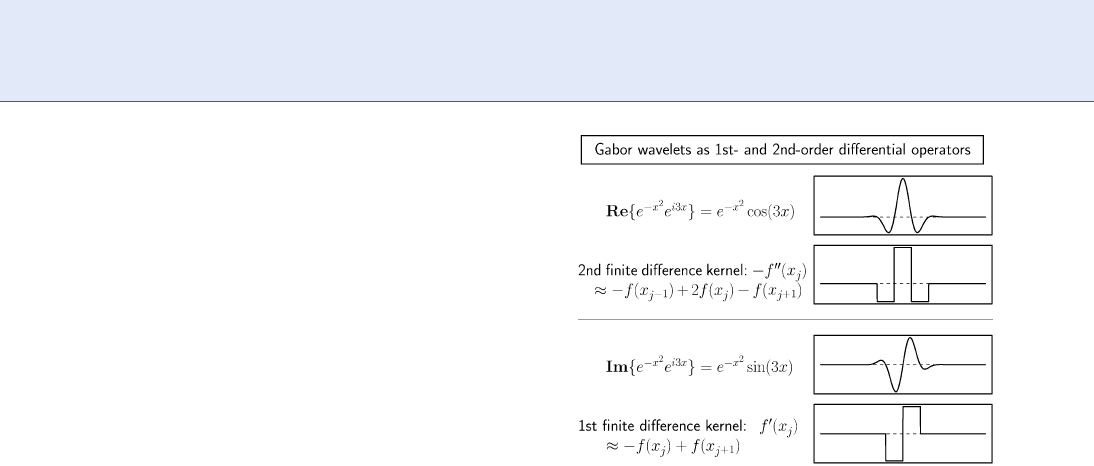
simply sampling particular points in the image. Thus,
the Gaussian scale parameter essentially creates a con-
tinuum that bridges the dichotomy between local
(point sampling) and global (Fourier) analysis, em-
bracing those classical approaches as the end points of
the continuum. At points between those two extremes,
the wavelets enable a kind of local spectral analysis to
be performed, extracting Fourier-like information
(e.g., phase and frequency descriptions) but in a local
region-specific fashion.
When Gabor wavelets are used as filters to convolve
with a signal, their effect depends of course on the
values chosen for their parameters. If the size of the
Gaussian is large compared w ith the modulation wave-
length, allowing several cycles of oscillation before
attenuation, then the complex wavelet becomes a nar-
rowband filter that allows a well-defined phase to be
assigned to each point in the output signal. Specifically,
the phase assigned to a point is the arctangent of the
ratio of the imaginary part to the real part of
the complex-valued result of the convolution with the
signal at that point. But for smaller Gaus sian space
constants that allow only one or two cycles of oscilla-
tion before attenuation, the wavelets behave instead
like approximate first- and second-order differential
operators.
Figure 3 illustrates (for the one-dimensional case)
how convolution with such wavelets approximates tak-
ing the first or second derivative of a signal. The real
and imaginary parts of a Gabor wavelet having such a
parameterisation are plotted in the first and third
panels. The second panel plots the second finite differ-
ence kernel, which is the discrete filter that should be
convolved with a discrete signal (a signal defined only
on a discrete domain, such as the integers or a regular
sampling lattice) in order to obtain the discrete ap-
proximation to a second derivative. There is an obvi-
ous resemblance between the continuous and the
discrete functions plotted in the first and second
panels. Likewise, the fourth panel plots the discrete
approximation for a first-derivative operator, called
the first finite difference kernel, which resembles the
imaginary part of a Gabor wavelet (third panel). The
definitions of the finite difference approximations
provided on the left in this Figure correspond to
Isaac Newton’s [11] formulae for estimating the first
or second derivatives (“Fluxions’’) of functions by
combining adjacent sample values on regular unit
sampling intervals, using weighting coefficients such
as [1, +2, 1]. In summary, the information extrac-
ted by convolving a signal with Gabor wavelets having
parameterizations as indicated in Fig. 3 is closely
related to the information obtained when the machin-
ery of the Calculus is used to extract the first and
second derivatives of a function. These properties con-
tribute to the richness of the repertoire deployed by
using complex-valued Gabor wavelets for image cod-
ing and analysis.
Gabor Wavelets for Iris Recognition
The goals of pattern recognition are, of course, rather
different from those of image encoding or analysis
perse. However, when designing a pattern recognition
system, it is nice to know that the image representation
chosen is in principle complete, meaning that all in-
formation is available in the encoding as demonstrated
by reconstructibility (Fig. 1), and also that interesting
operations are implementable in the encoding such as
extracting phase structure or derivatives (Fig. 3).
Iris Encoding and Recognition using Gabor Wavelets.
Figure 3 Analyzing and encoding signals or data using
Gabor wavelets with narrow Gaussians corresponds to
estimating a signal’s first- and second-derivatives (or finite
differences). These are approximated by convolving the
signal with the imaginary and real parts, respectively, of a
complex Gabor wavelet as shown in the right column.
Such operations correspond simply to weighting adjacent
samples algebraically (left column) with weights such as
[1, +1] or [1, +2, 1] as noted in 1671 by Isaac Newton
[11] in his theory of Fluxions.
792
I
Iris Encoding and Recognition using Gabor Wavelets
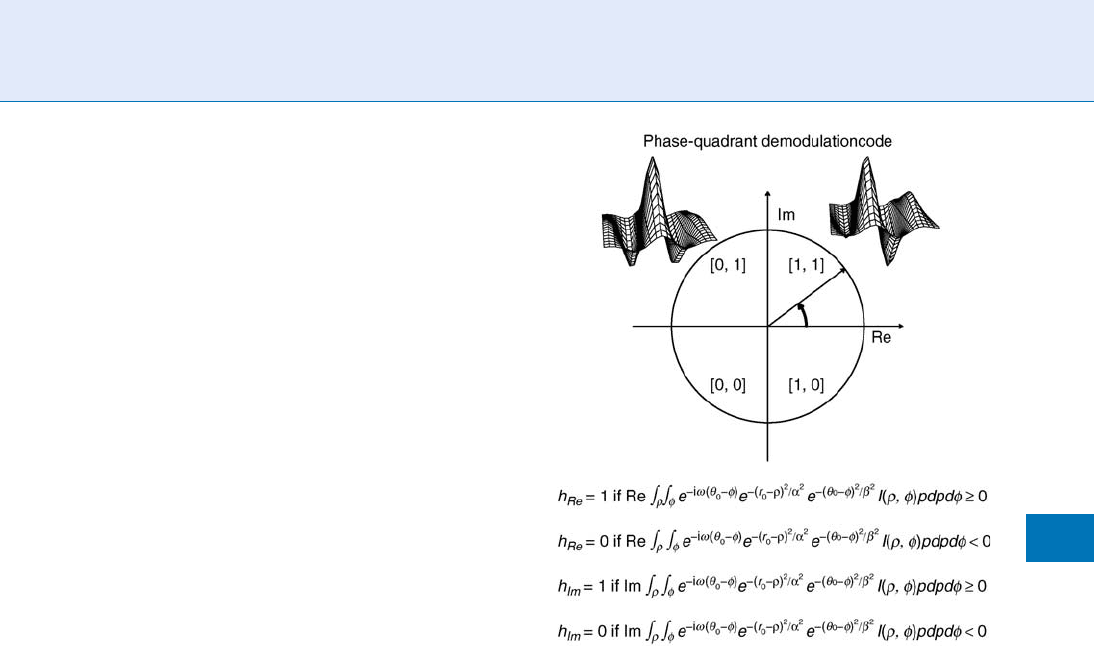
Interest in phase structure and in the zero-crossings
of bandpass signals was invigorated three decades ago
by some surprising proofs and critical demonstrati ons
of complete signal reconstructibility from either ty pe
of information alone [12]. Phase and zero-crossings
information are closely related: when a signal has been
bandpass-filtered (so that it has zero mean) and digi-
tized, then the most-significant-bit (MSB) of its sam-
ples corresponds to the most fundamental phase
information, the sign bit; and of course this bit tracks
the signal’s zero-crossings. In order to conjoin such
signal descriptions with representations on which
decisions about pattern identity can be made, we
need a kind of conceptual signal-to-symbol converter.
One very efficient way to bridge this gap is to deploy
the multi-scale Gabor wavelets as
▶ logico-linear
operators, constructing bit streams from the quantiza-
tion of the phas e information that the wavelets extract.
In the case of iris recognition, such a bit stream is
called an
▶ IrisCode, and it allows identification
decisions to be based on a simple test of statistical
independence [1].
Figure 4 illustrates how the paired real and imagi-
nary parts of 2D Gabor wavelets can be used to con-
struct a phase demodulation code. Local patches of the
image are projected onto both parts of the complex-
valued w avelets, and each pair of resulting inner pro-
ducts constitute the real and imaginary parts of a
complex number. Such a number has a phase and
a modulus corresponding to its polar components in
the complex plane, as portrayed in the phasor diagram.
If one chose to resolve phase angles to an accuracy of
only four quadrants as shown, then one would be
extracting just two bits of phase information per wave-
let. How finely should phase be quantized when
encoded? How spatially fine in size (how high in fre-
quency) should the discrete set of wavelets get? Both of
these questions relate to the number of degrees-of-
freedom one wishes to encode, and to how accurately
one can realign encodings of subsequent images of the
same iris in correspondence with an earlier image of it.
Sharpening the finest scale of detail extracted makes
the code for a given iris more detailed and more
unique (thereby further decreasing the likelihood of
False Matches), but by increasing the amount of min-
ute detail that must be matched, such a strategy also
increases the odds of failures-to-match (False non-
Matches) due to uncertainties or inadequacy in regis-
tration and alignment.
Code design issues also involve other aspects of the
Gabor wavelet parameterization, including their band-
width, which is determined by the effective number of
oscillatory cycles contained within the Gaussian enve-
lope before attenuation. More cycles cause narrower
bandwidth: filters that are more sharply tuned. Related
to this issue is the presence of a DC term (nonzero
area or volume in the integral) in the real part of a
Gabor wavelet if its bandwidth is broad (has only
few cycles within the Gaussian); this is undesirable
because it introduces code bit dependence on the
overall brightness of the image, which ought to be
irrelevant. However, the DC term can be nulled to
zero when determining the sampling rate of the dis-
crete taps which discretize the continuous wavelet, or
alternatively by tiny adjustments in the discrete taps
Iris Encoding and Recognition using Gabor Wavelets.
Figure 4 Constructing an IrisCode from phase analysis of
iris texture. The two surfaces plotted are the real and
imaginary parts of one 2D Gabor wavelet. Projecting a local
area of the iris image onto these functions and integrating
their products produces a complex number, whose real and
imaginary parts specify a phasor in the complex plane as
illustrated. Phase angle can be quantized at a chosen
resolution accuracy (in this diagram, two bits for four
quadrants) to create a phase-based IrisCode. The four
equations give the projection integrals that specify the bits.
Iris Encoding and Recognition using Gabor Wavelets
I
793
I
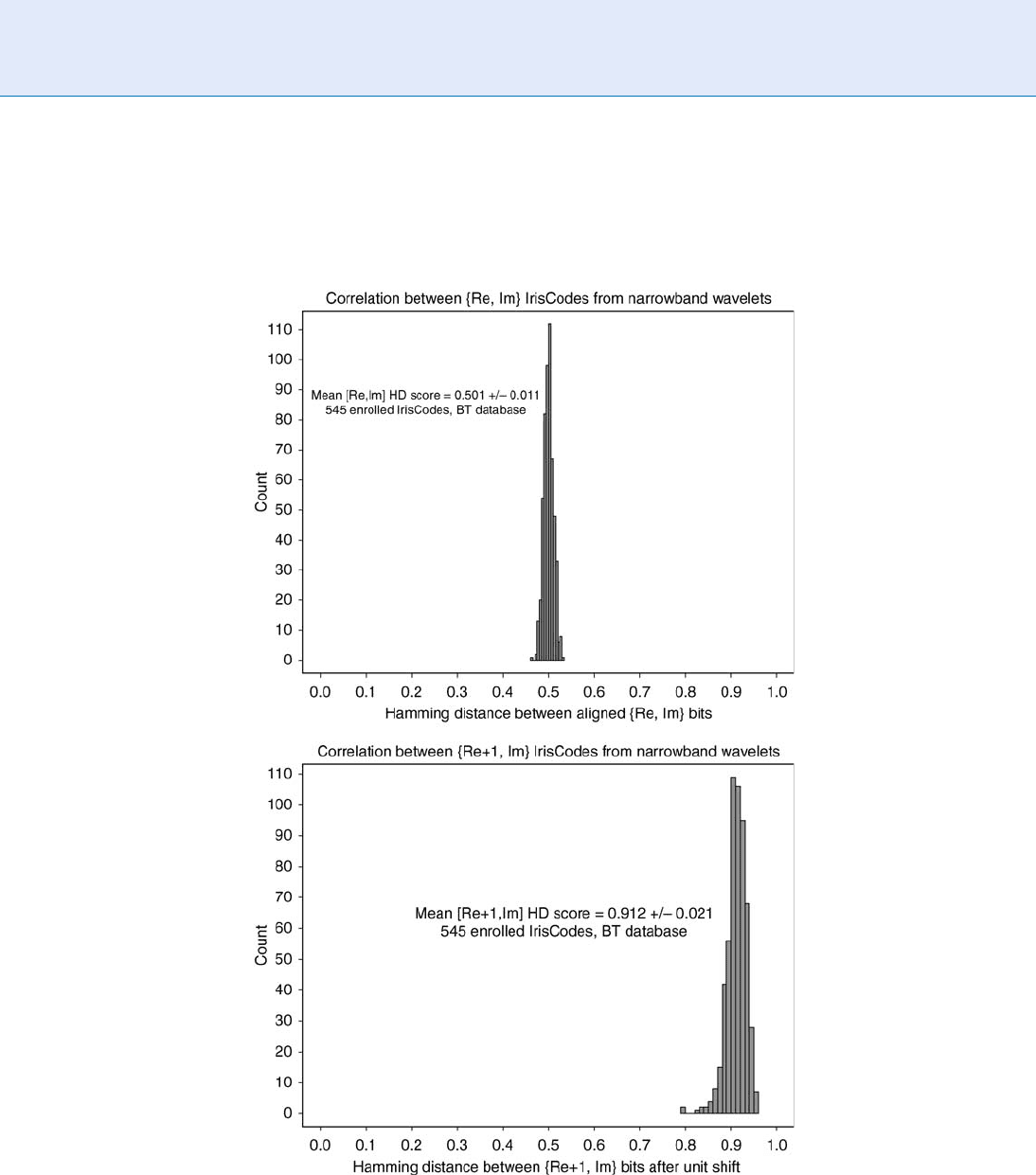
themselves. A more fundamental issue when specifying
code design is the phase coherence introduced by the
wavelets if their bandw idth is narrow, because this
reduces the randomness among the bits extracted by
the code.
This issue is illustrated in Fig. 5, whose panels show
the relationship between the real a nd imaginary parts
of an IrisCode. Any bit of an IrisCode has equal a priori
probabilities of being set or clear (ignoring the detec-
tion and masking of eyelids, eyelashes, reflections, or
Iris Encoding and Recognition using Gabor Wavelets. Figure 5 Correlations between the real and imaginary parts of
IrisCodes constructed from narrowband wavelets containing several cycles. Although orthogonality of the two
quadrature pair components of a wavelet ensures that corresponding real and imaginary bit pairs are independent
(upper panel), they show strong correlation when the two bit streams are simply shifted relative to each other by an
amount corresponding to p∕2 in wavelet phase (lower panel). This means that little additional entropy is gained by using
both quadrature components if the wavelets selected are narrowband.
794
I
Iris Encoding and Recognition using Gabor Wavelets

other corruptions), and one should expect the real and
imaginary bit pairs to be independent because of the
orthogonality of the corresponding parts of the Gabor
wavelets. Therefore, as with any sequence of ‘‘tosses’’
from two independent and fair ‘‘coins,’’ one should
expect a 50%-5 0% level of agreement between the
bits just by chance. For quadrature IrisCode bit pairs,
this is confirmed in the upper panel of Fig. 5, showing
the frequency with which different
▶ Hamming Dis-
tances (proportion of disagreeing bits) were observed
between the corresponding real and imaginary parts of
545 IrisCodes, computed over all pairs of {Re, Im}
corresponding bits. With a mean Hamming Distance
of 0.501 0.011, the expected finding of independence
between such equiprobable bits is clearly observed.
However, because the wavelets used to compute these
IrisCodes had relatively narrow bandwidths, a strong
degree of phase coherence is present in their outputs.
The consequence of such phase coherence is that the
real and imaginary parts be come hi ghly correlated
under a shift.
The lower panel of Fig. 5 plots a histogram of
Hamming Distances observed between the real and
imaginary bit streams after one stream has been shifted
by p ∕2 relative to the other. Now we see that these bit
streams are far from independent. Instead, with an
average probability of 0.912, they are simply comple -
ments of each other. The cause of this effect is clear
from the fact that narrowband wavelets (encompassing
many cycles) are almost equivalent to each other, or
negatively so, when shifted by p ∕2. In the case
illustrated by Fig. 5, the negative correlation is so
strong that there is little justification for using both
sets of bits if they are computed using relatively nar-
rowband wavelets; almost no additional entropy (or
information) is gained. Of course, this does not apply
to wavelets having broader bandwidth, when, as noted
in Fig. 3, the relationship is more like that between the
first and second derivatives. In that case, if one were
forced to choose one over the other, the second deriv-
ative (corresponding to the real part of a Gabor wave-
let) would be the better choice, because the first
derivative is sensitive to grad ients of illumination, as
may often occur in iris recognition systems using off-
axis illumination.
In the version of this algorithm that is currently
used in all public deployments of iris recognition
worldwide, the wavelet parameters were chosen to
optimize operation in identification mode, which
requires exhaustive search through enrolled databases
without succumbing to False Matches despite the large
numbers of possibilities. The benefit of operating
in this mode is that users need not assert their iden-
tities, as would be required by operation in verifica tion
mode in which only a one-to-one comparison is done
against a single identity asserted by, for example, a
token or card. But successful operation in identifica -
tion mode requires that the distribution of similarity
scores obtained when different irises are compared
must be confined by rapidly attenuating tails, since
that distribution is effectively being sampled a large
number N times when searching a database where
the number N of stored IrisCodes might correspond
to the size of a nation’s population. The larger the
number of samples N, the greater the likelihood of
finding a sample far out along the tail and thus a
possible False Match. Figure 6 shows the result of
200 billion iris cross-comparisons obtained from one
such national border-crossing deployment at all air,
land, and seaports of entry into the United Arab Emi-
rates. Since comparisons between different persons
never generate Hamming Distance (dissimilarity frac-
tion) scores smaller than about 0.25, at least among
these 200 billion such comparisons, we see that suc-
cessful recognition using this biometric requires only
that different images of a given iris are of sufficient
quality that no more than about 25% of their com-
puted IrisCode bits disagree. Under reasonable image
acquisition conditions, this is easily achieved.
Gabor Wavelets in Other Biometrics
A powerful advantage of the Gabor wavelet approach
to iris encoding and recognition is its great speed. The
complete execution time for all aspects of the image
processing, starting with a raw image, including the
localisation of the iris, detection of all boundaries
including eyelids and their exclusion, detection and
removal of eyelashes and other noise, normalization
in a dimensionless coordinate system, and demodula-
tion and compilation of the IrisCode with its masking
bits, is less than 30 ms on a 3 GHz processor. This
speed means that more than 30 complete image frames
can be fully processed per second, and so the process
can operate at the same rate as the video frame rate
itself. Of the 30 ms consumed per image frame, the vast
majority of processing time is spent on localization,
segmentation, and normali zation operations; less than
1 ms is consumed by demodulation with the Gabor
Iris Encoding and Recognition using Gabor Wavelets
I
795
I
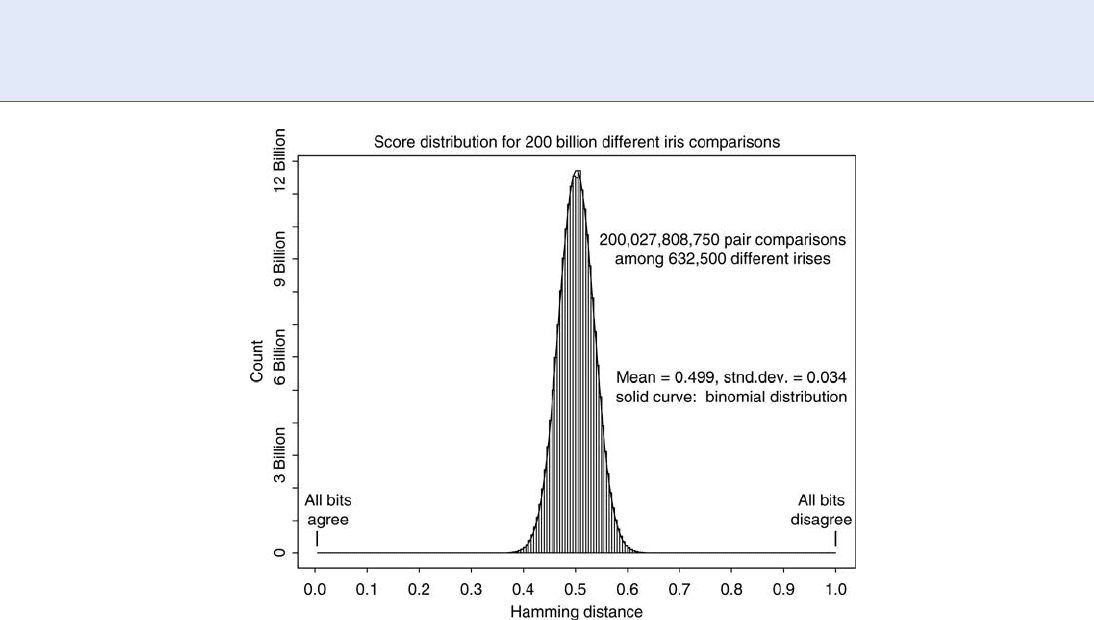
wavelets and creation of the IrisCode. Once an Iris-
Code has been computed, the simplicity of the com-
parison process and decision algorithm allows
databases to be searched at the speed of about 1 million
IrisCodes/second per 3 GHz processor.
Since these execution speeds for image processing
and for matching are very favorable compared to those
of other biometrics, efforts have been made to adapt
these methods for the other modalities as well. Notable
among these are face [13], fingerprint [14], and palm-
print [15] recognition. Besides the speed advantage, and
the design benefits of formulating a biometric recogni-
tion task as a test of statistical independence on the
outputs of logico-linear operators, the mathematical
merits of Gabor wavelets as reviewed in this chapter
also contribute fundamentally to the success of this
framework for image coding and pattern recognition.
Related Entries
▶ Active Contours in Iris Recognition
▶ Iris-on-the-Move™
References
1. Daugman, J.G.: High confidence visual recognition of persons by
a test of statistical independence. IEEE Trans. Pattern Anal.
Mach. Intell. 15, 1148–1161 (1993)
2. Daugman, J.G.: How iris recognition works. IEEE Trans. Circuits
Syst. Video Technol. 14, 21–30 (2004)
3. Meyer, Y.: Principe d’incertitude, bases hilbertiennes et algebres
d’operateurs. Bourbaki Seminar 662 (1985)
4. Daubechies, Y.: Orthonormal bases of compactly supported
wavelets. Comm. Pure Appl. Math. 41(7), 909–996 (1988)
5. Gabor, D.: Theory of communication. J. Inst. Electr. Eng. 93,
429–457 (1946)
6. Hubel, D.G., Wiesel, T.N.: Sequence regularity and geometry of
orientation columns in the monkey striate cortex. J. Comp.
Neurol. 158, 267–293 (1974)
7. Jones, J.P., Palmer, L.A.: An evaluation of the 2D Gabor filter
model of simple receptive fields in cat striate cortex. J. Neuro-
physiol. 58, 1233–1258 (1987)
8. Pollen, D.A., Ronner, S.F.: Phase relationships between
adjacent simple cells in the visual cortex. Science 212,
1409–1411 (1981)
9. Daugman, J.G.: Uncertainty relation for resolution in
space, spatial frequency, and orientation optimised by two-
dimensional visual cortical filters. J. Opt. Soc. Am. A 2,
1160–1169 (1985)
Iris Encoding and Recognition using Gabor Wavelets. Figure 6 Distribution of Hamming Distance scores (fraction of
disagreeing bits) obtained in 200 billion cross-comparisons among 632,500 different iris patterns enrolled in the
United Arab Emirates border-crossing deployment. The rapid attenuation of the left tail means that False Matches are
avoided even in exhaustive searches through national databases, provided that the decision policy allows no more than
about 25% of the bits to disagree (HD < 0.25) when declaring a match.
796
I
Iris Encoding and Recognition using Gabor Wavelets
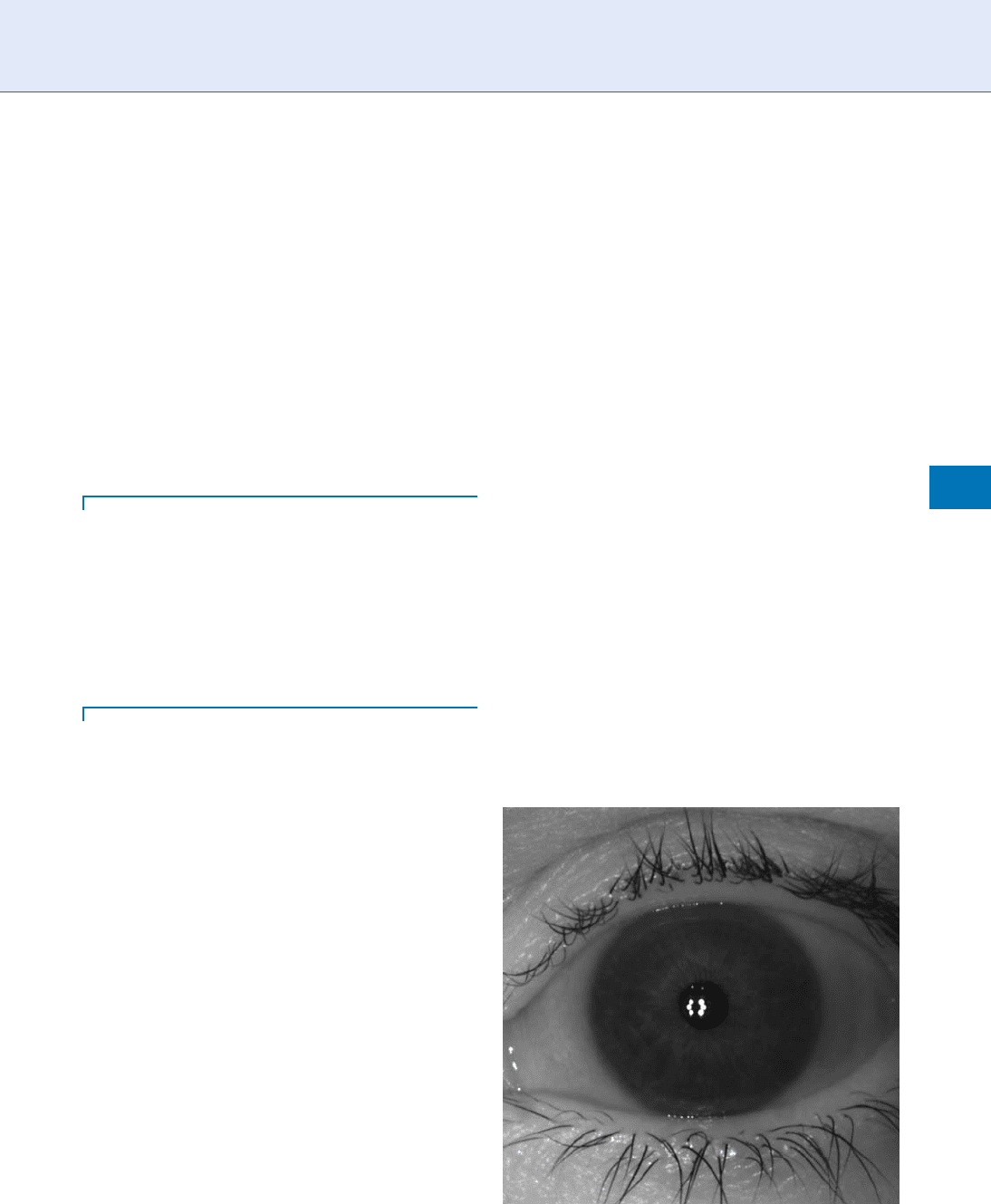
10. Daugman, J.G.: Complete discrete 2D Gabor transforms by
neural networks for image analysis and compression. IEEE
Trans. Acoust. Speech Signal Process. 36, 1169–1179 (1988)
11. Newton, I.: Method of fluxions. Manuscript in Trinity College
Library, University of Cambridge (1671)
12. Oppenheim, A.V., Lim, J.S.: The importance of phase in signals.
Proc. IEEE 69, 529–541 (1981)
13. Wiskott, L., Fellous, J.M., Kuiger, N., von der Malsburg, C.: Face
recognition by elastic bunch graph matching. IEEE Trans. Pat-
tern Anal. Mach. Intell. 19, 775–779 (1997)
14. Jain, A.K., Prabhakar, S., Hong, L., Pankanti, S.: Filterbank-
based fingerprint matching. IEEE Trans. Image Process. 9,
846–859 (2000)
15. Kong, A.W.K.: Palmprint Iientification based on generalization
of irisCode. Ph.D. thesis, University of Waterloo, ON, Canada
(2007)
Iris Image Capture Device
▶ Iris Acquisition Device
▶ Iris Device
Iris Image Data Interchange
Formats, Standardization
JAMES L. CAMBIER
Crossmatch Technologies, RCA Blvd, FL, USA
Synonyms
Iris interchange format standards; Iris data interchange
standards
Definition
Iris recognition is a biometric technology that uses the
unique, stable, and repeatable texture patterns ob-
served within the iris of the human eye, the colored
annular ring that surrounds the pupil. Iris recognition
systems typically consist of specialized cameras and
software that processes images of the eye to extract
and encode iris features in a template, and match the
presented iris templates to those in a database to iden-
tify the indiv idual. Applications include controlled
access to buildings, border security, trusted traveler
programs, and authentication of emergency aid, enti-
tlement, and citizen benefit recipients. Iris image inter-
change standards have been developed to facilitate
the exchange of iris image data among diverse cameras,
processing algorithms, and biometric databases. Exist-
ing standards include ANSI INCITS 379 Iris Image
Interchange Format and ISO/IEC 19794-6 Information
technolog y: Biometric data interchange formats –
Part 6: Iris image data.
Introduction
The human ▶ iris is a colored annular ring that sur-
rounds the
▶ pupil, a variable aperture that admits
light to form an image on the
▶ retina, the light-sen si-
tive surface in the back of the eye. The iris is a mu scular
structure that contains a variety of texture features,
including pits, furrows, and radial striations (Fig. 1).
The rich and unique texture of the iris has long been
recognized, and a number of biometric systems based
on the iris have been described [1–4]. Particular algo-
rithmic approaches to the extraction, encoding, and
matching of iris texture features have also been pub-
lished [5–8].
With the advent of multiple vendors of iris cameras
and systems, and various algorithmic approaches to
Iris Image Data Interchange Formats, Standardization.
Figure 1 Iris image.
Iris Image Data Interchange Formats, Standardization
I
797
I
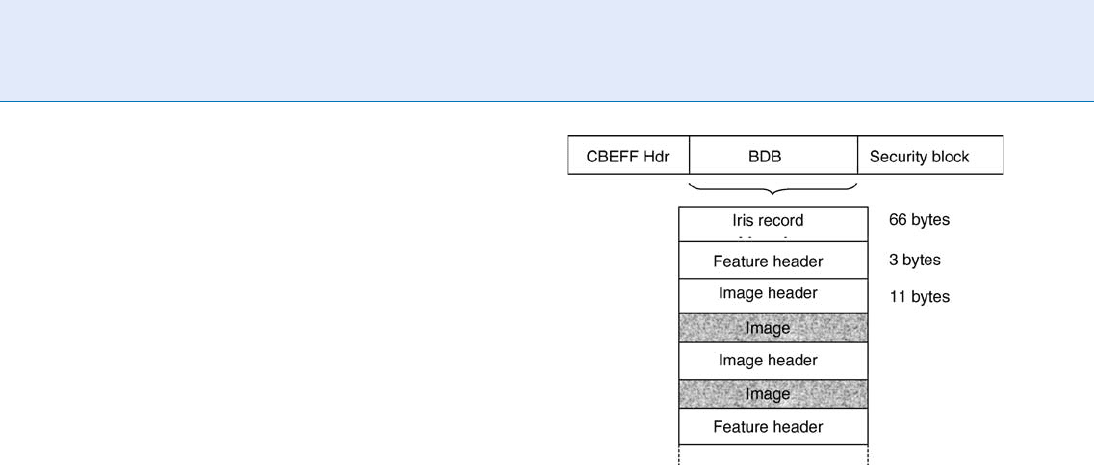
iris-based recognition, it became clear that the devel-
opment of data interchange standards for iris images
would (1) facilitate the exchange of iris images
among multiple vendors, applications, and algorithms,
(2) enable the compilation of iris image databases for
comparative testing and evaluation of multiple algo-
rithms, and (3) support the evolutionary development
of new iris algorithms by preserving existing enroll-
ment databases in the form of reusable images.
The development of iris standards has been a col-
laborative effort of a number of biometric vendors,
government agencies, and academic institutions, and
has resulted in both a US standard, ANSI INCITS 379
Iris Image Interchange Format [9], and an interna-
tional standard, ISO/IEC 19794-6 Information tech-
nology: Biometric data interchange formats – Part 6:
Iris image data [10]. The ANSI standard was developed
first and became the basis for the international stan-
dard; as a result the two are virtually identical.
The iris standards support two different data for-
mats, a
▶ rectilinear format in which the iris image
is represented in standard Cartesian (x y) coordi-
nates, and a
▶ polar format, in which the (approxi-
mately) circular iris is represented in polar (r y)
coordinates. The rectilinear format provides the high-
est interoperability, while the polar format retains
only the area of specific interest, the iris, and thus
provides a more compact representation. The stan-
dard allows a number of different image intensity
representations (color, monochrome, etc.), compres-
sion schemes, and geometric orientations. Finally, an
appendix to the standard contains a set of recommenda-
tions for iris image capture, addr essing quality metrics,
resolution, illumination, distortion, noise, orientation,
and other properties.
Data Formats
The iris image record is a nested structure that contains
several headers and one or more images (Fig. 2). The
overall structure consists of a CBEFF header [11], the
Biometric Data Block (BDB), and a Security Block
(SB). The CBEFF header contains information about
image quality, the origin of the BDB format used, and
information about the type of biometric contained in
the data record. The BDB contains an Iris Record
Header, one or two Feature Headers, and one or
more images, each preceded by an Image Header. The
Record Header contains information and parameters
specifying the format of all of the images in the record,
such as geometric format (rectilinear or polar), orien-
tation, dimensions, number of intensity levels, number
of intensit y bands (i.e., monochrome, color, etc.), and
compression methods. The Feature Header indicates
which eye was imaged (left or right), if know n, and the
number of images recorded for that eye. Finally the
Image Header contains an image sequence number,
image quality value, size of the image data, and infor-
mation about the rotational position of the iris, if
known.
The rectilinear image format is a conventional
image composed of rows and columns where each
entry corresponds to one pixel (picture element) pro-
duced by the image sensor. If the image contains mul-
tiple color bands, such as red-green-blue, each pixel is
recorded as three sequential values.
An image in polar format is produced by proces-
sing the rectilinear image to find the iris center, pupil
boundary, and outer iris boundary or
▶ limbus. The
portion of the image containing the iris is then sam-
pled along radial lines emanating from the iris center
and extending from the pupil boundary to the iris
boundary at particular angles. The result is an image
in polar coordinates. It is stored as a matrix in which
each column corresponds to one angular orientation
y and each row corresponds to a particular radial
distance r. Interoperability of polar images may be
limited by the accuracy and consistency with which
Iris Image Data Interchange Formats, Standardization.
Figure 2 Iris image data record.
798
I
Iris Image Data Interchange Formats, Standardization

the pupil and iris boundaries are determined. Their
advantage is very compact iris data representation,
since no image information within the pupil or outside
the iris is included.
Image Properties
The properties recorded for rectilinear and polar
images differ to some extent. The properties are as
follows, with these differences noted:
Image orientation – the images may be recorded in
‘‘canonical’’ form, in which the top of the eye is at the
top (first row) of the image and, for a right eye, the
nasal side of the eye (that closest to the nose) is on
the right side of the image. Alter natively, the image
may be flipped vertically or horizontally. For polar
images the orientation refers to the rectilinear image
used to produce the polar image.
Scan type – the images may have been collected
using progressive scanning, in which each row is cap-
tured in sequence, or interlaced scanning, in which all
odd rows are captured followed by all even rows. Note
that in the latter case the image is still stored in strict
row sequence.
Data format – the images may be uncompressed (or
‘‘raw’’) or compressed; they may be color or mono-
chrome, and if compressed the applicable compression
standard is referenced.
Image size – the image dimensions are recorded as
width and height, recognizing that for polar format the
width corresponds to angular samples and the height
to ra dial samples. The number of bits allocated to each
intensity value is also recorded.
Rotation angle – relative rotation between enroll-
ment and recognition images must be either corrected
or accommodated in the match process by searching
over a range of rotations [5, 7] or using templates
based on rotation-invariant features [3 ]. Some cameras
are capable of approximating the
▶ rotation angle by
capturing both eyes simultaneously and calculating the
angle of the interpupillary line with a horizontal refer-
ence. This angle information may be recorded.
Camera information – space is allocated in the
image properties to record a unique identifier for the
camera and the date and time of capture.
Occlusion marking – local areas of the iris may be
occluded by reflections, eyelids, or eyelashes and
therefore, should not be used to generate template
information. The standard includes fields for recording
whether occlusions have been detected, and if so how
they are marked in the image data (usually as a re-
served intensity value).
Image Quality
The iris standard allows the originator of an iris image
to indicate the quality of the image on a scale from 1 to
100. The interpretation of the quality score is at the
discretion of the originator, but the following general
quality interpretations are recommended:
1–25 – unacceptable quality
26–50 – low quality, suitable for verification in low-
cost systems
51–75 – medium quality, suitable for verification iden-
tification (one to many matching) in medium se-
curity applications
76–100 – highest quality images, suitable for
enrollment
Image Capture Recommendations
Appendix A of the standard provides specific recom-
mendations on capture of iris images, based on vendor
experience in commercial deployments of iris recogni-
tion. These recommendations include the following:
Resolution
Grayscale range
Illumination wavelength
Contrast
Iris visibility
Pixel aspect ratio
Image scale
Optical distortion
Noise content
Image orientation
Subject presentation
ANSI and ISO Differences
Although the American National standard and the
international standard are more or less identical there
Iris Image Data Interchange Formats, Standardization
I
799
I
